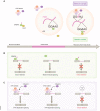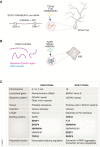Satellite RNAs: emerging players in subnuclear architecture and gene regulation
- PMID: 37526230
- PMCID: PMC10505914
- DOI: 10.15252/embj.2023114331
Satellite RNAs: emerging players in subnuclear architecture and gene regulation
Abstract
Satellite DNA is characterized by long, tandemly repeated sequences mainly found in centromeres and pericentromeric chromosomal regions. The recent advent of telomere-to-telomere sequencing data revealed the complete sequences of satellite regions, including centromeric α-satellites and pericentromeric HSat1-3, which together comprise ~ 5.7% of the human genome. Despite possessing constitutive heterochromatin features, these regions are transcribed to produce long noncoding RNAs with highly repetitive sequences that associate with specific sets of proteins to play various regulatory roles. In certain stress or pathological conditions, satellite RNAs are induced to assemble mesoscopic membraneless organelles. Specifically, under heat stress, nuclear stress bodies (nSBs) are scaffolded by HSat3 lncRNAs, which sequester hundreds of RNA-binding proteins. Upon removal of the stressor, nSBs recruit additional regulatory proteins, including protein kinases and RNA methylases, which modify the previously sequestered nSB components. The sequential recruitment of substrates and enzymes enables nSBs to efficiently regulate the splicing of hundreds of pre-mRNAs under limited temperature conditions. This review discusses the structural features and regulatory roles of satellite RNAs in intracellular architecture and gene regulation.
Keywords: T2T genome; membraneless organelle; noncoding RNA; satellite DNA; stress response.
© 2023 The Authors. Published under the terms of the CC BY 4.0 license.
Conflict of interest statement
The authors declare that they have no conflict of interest.
Figures




References
-
- Altemose N (2022) A classical revival: Human satellite DNAs enter the genomics era. Semin Cell Dev Biol 128: 2–14 - PubMed
-
- Aly MK, Ninomiya K, Adachi S, Natsume T, Hirose T (2019) Two distinct nuclear stress bodies containing different sets of RNA‐binding proteins are formed with HSATIII architectural noncoding RNAs upon thermal stress exposure. Biochem Biophys Res Commun 516: 419–423 - PubMed
Publication types
MeSH terms
Substances
LinkOut - more resources
Full Text Sources

